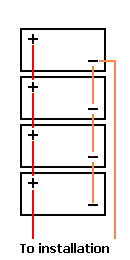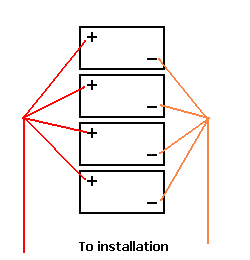Try our solar cost and savings calculator
2V batteries with 4 bolt connetion between batteries - how to connect the cabel?
Collapse
X
-
Leave a comment:
-
Yes, it is, and it does suggest that you need to make sure that all of your 24 volt utilization equipment can take that high a voltage or else provide a way to disconnect it when the charging voltage is too high.
Nominal 12 volt equipment intended for use in a vehicle will be designed for a wider voltage range. Equipment intended for use at 12 volts AC or DC in a fixed location may not have that same tolerance. Especially when, like some lighting equipment, it is designed to be fed by a regulated DC supply rather than directly from a battery.Leave a comment:
-
Check your documentation and tell me the recommended FLOAT voltage. Should be around 2.35 vpc. 2.45 would be Equalize, not Float.Leave a comment:
-
Leave a comment:
-
Were you able to find this 75mm "kobber bar" as a way to make your cable terminations?www.alternativeenergi.no is very much alive. Their connection advice was as follows:
....
More than 2000W? - mount a 75mm2 kobber bar (25mm x 3mm / 1" x 1/8"(ish) ) on top of the 4 post's and then connect the cable on one of them.Leave a comment:
-
The documentation state:
Effect of Temperature on Charging Voltage
As temperature rises, electrochemical activity in a battery increases. Similarly, as temperature falls, electrochemical activity decreases.
Therefore, conversely, as temperature rises, charging voltage should be reduced to prevent overcharge and increased as temperature falls to
avoid undercharge. In general, to assure optimum service life, use of a temperature compensated charger is recommended. The
recommended compensation factor for SL batteries is -3mV/℃/Cell (standby use) and-5mV/℃/Cell (cyclic use). The standard center point for
temperature compensation is 25℃. Figure 4 shows the relationshipbetween temperatures and charging voltages in both cyclic and standby
applications.
7 instead of 25 deg C makes 18 x 3mV = 54mV in increased Charging Current - > 2.45V + 0.054V = 2.504V , 15.024 in 12V world and 30.048 in 24W setup - isn't this a very hight voltage?Leave a comment:
-
Leave a comment:
-
Leave a comment:
-
There are basically two charging algorithms of constant voltage and constant current. Constant voltage is pretty straight forward in that you apply a precision controlled voltage to the battery.
Constant current is different, there is no voltage associated with it. The charger pushes a set amount of current into the battery regardless of how much voltage is required. However please ignore that method, it is dangerous and can seriously over charge the batteries. They recommend .1C which also is C/10. So for example if those are 2000 AH batteries they are saying push 200 amps of current into them for 20 to 24 hours. Do not do that.
Instead apply a EQ charge using your generator which is a constant voltage method running @ 2.45 volts per cell or 29.4 volts. You still need a charger capable of C/10 charge current.Leave a comment:
-
Kick starting sleeping batteries
This set of batteries has been sleeping for a while. Fuli users manual says the following on the subject:
RECHARGING STORED BATTERIES
In general, to optimize performance and service life, it is recommended that FULI batteries which are to be stored for extended periods of time be given a supplementary charge, commonly
referred to as a “top charge ", periodically. Since any battery loses capacity through self discharge, it is recommended that, prior to putting the battery into service, a process called “top
charging “be applied to any battery which has been stored for a long period of time.
Excluding conditions in which storage temperatures have been abnormally high, top charging is recommended within the following parameters(Table 2):
Battery Age
Top Charging Recommendations
Within 6 months after manufacture 4 to 6 hours at constant current of 0.1C Amps or 15
to 20 hours at constant voltage of 2.45Vpc
Within 12 months after manufacture 8-10 hours at constant current of 0.1C Amps or
20-24 hours at constant voltage of 2.45Vpc
In order to successfully top charge a battery stored for more than 12 months, the open circuit voltage must be checked to ensure that it is
higher than 2.0 volts per cell.
Therefore ALWAYS check the open circuit voltage FIRST. If the open circuit voltage of the battery is 2.0 Vpc or lower, please refer to us
prior to attempting to “Top Charge ".
Fuli also write this about charging in general:
Constant Voltage Charging:
This is the recommended method of charging for VRLA batteries. It is necessary to closely control the actual voltage to ensure that it is
within the limits advised.
Float Service: 2.25-2.30 Vpc at 25℃ .
Cycle Service: 2.35-2.45 Vpc at 25℃
FULI suggests that the initial current be set within 0.2C Amps. Figure 1 shows one example of a constant voltage charging.
Constant Current Charging
This method of charging is generally not recommended for VRLA batteries, but is an effective method for charging a number of series
connected batteries at the same time. It is necessary to understand that if the batteries are not removed from the charger after reaching a
state of full charge, considerable damage will occur to the batteries due to overcharging. Figure 2 shows the characteristics of a FULI
battery under constant current charging conditions
I must admit I am puzzled about the recommendations "Within 12 months after manufacture 8-10 hours at constant current of 0.1C Amps or
20-24 hours at constant voltage of 2.45Vpc" - 0.1C Amps at what voltage?
Any views on this?Attached FilesLeave a comment:
-
The "Answer:"
The Norwegian company that installed your batteries on the oil rig is still in business: www.getek.no and the dealer selling the identical Fuli batteries is www.alternativenergi.no
Correction: Getek is out of business!
www.alternativeenergi.no is very much alive. Their connection advice was as follows:
If connect to an inverter off less than 2000W it's sufficient to connect to one of the 4 post's.
(This I assume also answer the question about 4, 2 or one 2V cell)
More than 2000W? - mount a 75mm2 kobber bar (25mm x 3mm / 1" x 1/8"(ish) ) on top of the 4 post's and then connect the cable on one of them.
I am planning to use 2 70mm2 cable and was thinking of mounting them on post 2 and 3.
However...............
This still leaves me with a 100$ parallel cabling questions since I a do have two of these battery series and have no other options than to put them in parallel.
In my mind this leaves me with two options:
1) Connect the 2 70mm2 (+) cables to #1 and the 2 (-) cables to battery pack #2 and connect the 2 battery pack together with 2 70mm2 cables on both sides (+ & -)
Like this only with two batteries:

or the more complex
2) Make a double T-connection on each side making the cable length exactly the same from inverter to battery
like this (again only with two batteries):

Nr 2) is probably the best however it is more complex and needs a connect "box" outside the nice protection of the battery "house"Leave a comment:
-
I do not know if it is available in your area but worth ordering SanChem NO-OX-ID A Special. Absolutely the best compound money can buy. Used by all electric, telephone, water, and structural utilities. If applied correctly will out live you and the system. All you need is a small tube of it.Leave a comment:
-
I've never seen solder used on battery terminals before.
Leave a comment:
-
Leave a comment:
Copyright © 2014 SolarReviews All rights reserved.
Powered by vBulletin® Version 6.1.3
Copyright © 2025 MH Sub I, LLC dba vBulletin. All rights reserved.
Copyright © 2025 MH Sub I, LLC dba vBulletin. All rights reserved.
All times are GMT-5. This page was generated at 11:11 PM.
Leave a comment: